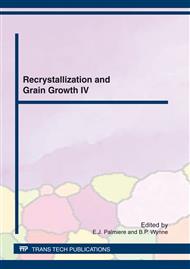p.186
p.191
p.197
p.203
p.211
p.219
p.227
p.235
p.243
Advances in Grain Growth Theory
Abstract:
The theoretical description of grain growth was based for many years on the so-calledspherical model. The spherical model represents a polyhedral grain with N faces and a volume, V ,by a sphere with an equal volume having the equivalent grain radius, R. That model leads to severalinteresting results concerning normal and abnormal grain growth as well as grain size distribution.Nevertheless, representation of grains by spheres entails a fundamental limitation: namely, all topo-logical information of the polyhedral grain is forsaken. The rich variety of grain shapes occurringin three-dimensional polycrystalline networks, however, makes their energetic and kinetic analysesextremely difficult. To simplify analyses of isotropic polycrystals, average N-hedra and generalizedN-hedra ANHs or GNHs .N D 3; 4; 5;1/ were created as a set of regular polyhedra, consisting ofN identical faces that act as topological proxies for analyzing irregular grains containing N mixedfaces. The adoption of ANH/GNH as representations of polyhedral grains led to further progress inour understanding of grain growth, particularly those aspects related to topological behavior. This pa-per summarizes some recent advances of representing polyhedral grains by ANHs/GNHs rather thanby spheres.
Info:
Periodical:
Pages:
211-218
Citation:
Online since:
April 2012
Authors:
Keywords:
Price:
Сopyright:
© 2012 Trans Tech Publications Ltd. All Rights Reserved
Share:
Citation:


